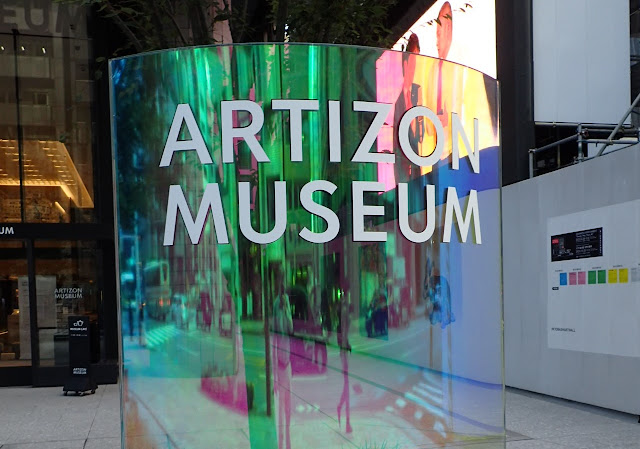One good thing about the Covid lockdown that hit the world between 2019 and 2022 was that it allowed Tokyo's hardworking art exhibition business to disengage from the day-to-day business of end-to-end exhibitions, and enabled them to rejig the art experience in new and radical ways.
The museums were then able to relaunch themselves to audiences emerging from Covid lockdown without too much lag or drag from the past.
Three cases in particular show the way the art arrow is now pointing.
One of the most notable ones was undoubtedly the Bridgestone Museum of Art, which entered its cocoon in 2015, when the rather constrained spaces of the old museum closed down to make way for a massive rebuild that expanded the museum's space by, at my rough estimation, at least ten times.
Bigger doesn't always mean better, by the way, but better does always mean better, and the new Bridgestone Museum, now rechristened the "Artizon" (various puns in there) is definitely better.
The new design gives the formerly cramped museum a spacious, vertical feel, typified by a 16-meter vertical column in the main lobby reaching up to the higher floors, along with a grand staircase, and a central balconied atrium (see image).
This embrace of the vertical energises the museum, a fresh feel that is further amplified by the high quality detailing, including terrazzo tiles, lattice windows looking out on the bustling central Tokyo area, sleek modernism, and the tasteful positioning of older artworks from the collection that represents the mainstream of traditional Western art.
Christian Daniel Rauch's Victoria
When I was there, the museum generously accommodated two excellent exhibitions in its high-ceilinged galleries, namely Akira Yamaguchi's postmodern take on Nihonga and an extensive exhibition of photography documenting many of the key artists of Japanese Modernism.
Find out more about Artizon here
Around the same time the Bridgestone was mutating into the Artizon, another one of Tokyo's best loved art museums was undergoing a major rebooting, namely the Seiji Togo Memorial Sompo Museum of Art, best known, when it opened back in the "bubble" year of 1976, for being on the 42nd floor of the high-rise Sompo Japan Building and for acquiring one of Van Gogh's "Sunflowers" a few years later for the then record-breaking price of forty million dollars.
Find out more about Artizon here
__________________
Around the same time the Bridgestone was mutating into the Artizon, another one of Tokyo's best loved art museums was undergoing a major rebooting, namely the Seiji Togo Memorial Sompo Museum of Art, best known, when it opened back in the "bubble" year of 1976, for being on the 42nd floor of the high-rise Sompo Japan Building and for acquiring one of Van Gogh's "Sunflowers" a few years later for the then record-breaking price of forty million dollars.
But while Artizon emphasises the vertical, the nub of the Sompo project was to relocate the sky-rise museum back to ground level. This was presumably because of health, sustainability, and insurance cost issues caused by the shunting of precious artworks and delicate elderly visitors 200 meters up into the sky. Personally, I always the views from up there justified the minor inconvenience.
The new low-rise Sompo is designed to create architecture "connected to the city," with a sleek, modernist design, subtly referencing the museum's traditions.
The museum's exterior is modelled after the graceful curves of a female figure in a way characteristic of the works of Seiji Togo, the main artist in the Sompo's permanent collection. Yes, the building is pure washed out sexuality, but with enough modernism to make it seem like a Puritan temple:
The museum's exterior is modelled after the graceful curves of a female figure in a way characteristic of the works of Seiji Togo, the main artist in the Sompo's permanent collection. Yes, the building is pure washed out sexuality, but with enough modernism to make it seem like a Puritan temple:
Sompo Museum of Art
Learn more about the Sompo Museum of Art here
__________________
Perhaps the most radical of the new designs we are covering here is the new Digital Art Museum that now occupies part of the new Azabudai Hills complex that opened in 2023.
The Museum has essentially head-hunted the TeamLab collective, an outfit that was already operating a popular digital art experience on Tokyo's waterfront, and placed it in a convenient corner of the sprawling high rise development.
Azabudai Hills
The Digital Art Museum may not be as distinctive in its architectural imprint as Artizon or the Sompo, and there is even a suspicion that the space it occupies may be "repurposed" at some future date, but right now it is offering up some of the more mind-bending immersive art exhibits in Tokyo and is transcending both the borders of conventional art and the mundane museum.
Digital Art Museum
But after the sensory overload on offer here, there is actually nothing nicer than wandering around a few dabs of oil on canvas, squinting at the name plates.
Cezanne's Mont Sainte-Victoire and Château Noir (c. 1904-06) at the Artizon
Learn more about the Digital Art Museum here
















































No comments:
Post a Comment
Please feel free to comment. All comments are moderated.